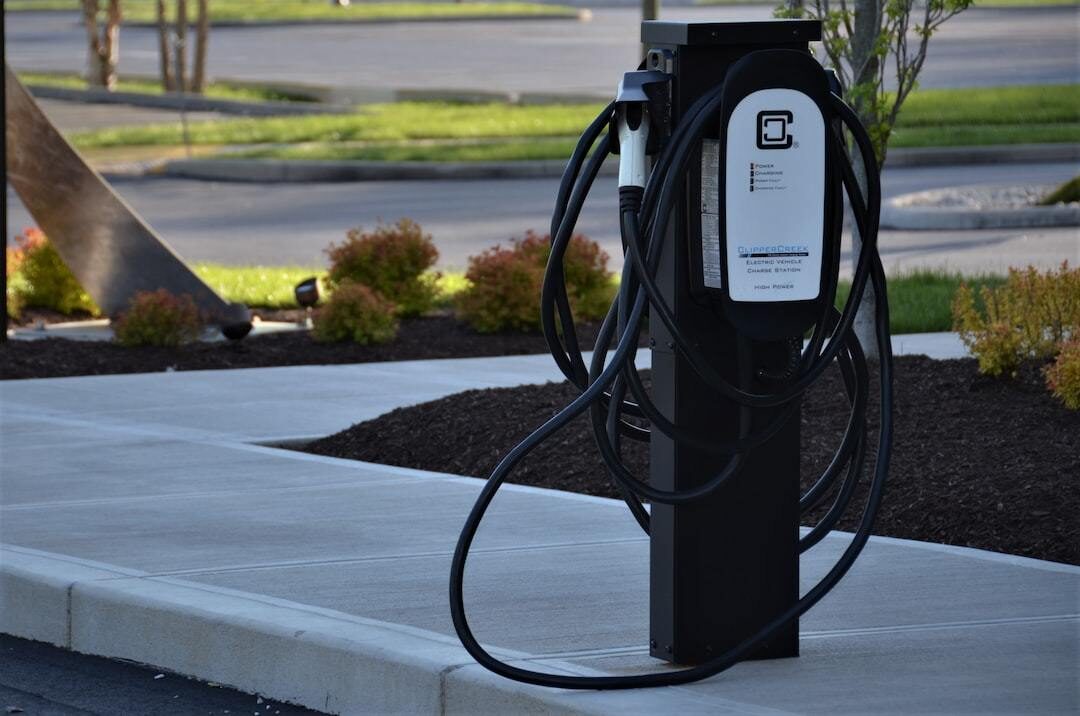Imagine plugging in your electric vehicle (EV) at night and waking up to a fully charged car ready to tackle the day. This piece dives deep into how these chargers work, offering faster charging times that turn hours into mere minutes of waiting. You’ll get insights on easy installation processes, comparing costs and ultimately picking the perfect model for your needs.
QG Smart Home offers EV charger installs, our electricians in Bucks County are ready to help with your next EV Charger!
We’ll also explore how integrating Level 2 EV chargers can significantly boost your driving range with minimal downtime, making them an ideal choice for both home and public use. By the end of this read, you’ll have all you need to make informed decisions about upgrading from a standard outlet to a more efficient charging solution for your electric ride.
The Basics of Level 2 EV Chargers
Understanding the Functionality and Benefits
Imagine needing less time to fuel your electric car than it takes to watch a couple of episodes of your favorite TV series. That’s where Level 2 EV chargers come into play, stepping up from the slower pace of their Level 1 counterparts. Unlike standard outlets that offer a meager power source, these chargers use a robust 208-240v power supply, which can pump energy into your vehicle’s battery up to eight times faster.
This speed boost means you’re looking at significantly reduced charging times for your electric vehicle (EV). Specifically, while a typical charger might trickle charge an EV overnight or longer, a Level 2 charger slashes this time dramatically, letting drivers regain about 20 to 30 miles of range per hour plugged in. This is especially handy if you forgot to plug in the night before or need an urgent top-up before heading out.
Besides just being quicker at replenishing your ride’s juice, these chargers are marvels when considering ease-of-use and compatibility with various vehicles. Thanks mostly to standardized ev charging connectors like those found on many models today—installation is usually straightforward too. And although installing one may seem daunting initially—with costs potentially hitting over $1,000 when factoring in professional help—it’s an investment that pays dividends in convenience and efficiency down the road.
Folks often wonder about the real difference between alternating current (AC) versus direct current (DC) fast chargers; it boils down primarily to how much time you’ve got on hand and how quickly you need that full tank. While DC offers lightning-fast speeds perfect for quick pit stops during long trips—a bit like swinging by for gas—level two stations provide more practical everyday solutions without breaking the bank or requiring hefty infrastructure changes akin to what commercial properties face.
Level 2 EV chargers are game-changers, making electric car charging way faster and more convenient. They turn what used to be an overnight task into just a few hours, giving your ride enough juice for about 20 to 30 miles per hour of charging. Easy to install and compatible with most vehicles, they’re a smart pick for everyday use.
Installation Insights for Level 2 EV Chargers
Navigating the Installation Process
Deciding to install a Level 2 EV Charger at home is like upgrading from a slow, drip coffee maker to an espresso machine—it’s all about speed and efficiency. But before you can enjoy that quick jolt of electricity into your electric vehicle (EV), there are some key steps and considerations.
First off, understand that installing a Level 2 charger requires more than just plugging it into any old outlet. These chargers need a dedicated circuit because they use a power source ranging between 208-240v, similar to what powers clothes dryers in many homes. This setup delivers power up to eight times faster than its Level 1 counterparts, making sure your car gets back on the road quicker.
To get started, you’ll need help from certified electricians who have experience with the electrical infrastructure necessary for these types of installations. They will ensure everything is up to code and safely installed so that when you plug in your car, everything works seamlessly.
Cost Breakdown and Financial Incentives
The sticker shock of setting up your first home-based charging station might make you pause—installing the initial level two charger can cost at least $1,000 due primarily to needing a dedicated circuit along with professional installation by certified electricians. However, considering this as an investment towards convenience and long-term savings should ease that concern somewhat.
Luckily, financial incentives may be available, including rebates or tax credits offered by local governments or utility companies aimed at encouraging EV adoption. Such programs could significantly offset installation costs while supporting eco-friendly transportation options. Remember though: specific details vary based on location; always check local resources for current offers.
Upgrading to a Level 2 EV Charger boosts charging speed, but it requires professional installation and a dedicated circuit. While the upfront cost may be high, rebates or tax credits can help offset expenses, making it an investment in convenience and sustainability.
Selecting Your Ideal Level 2 Charger
Compatibility Checks
When you’re in the market for a level 2 EV charger, think of it like finding a soulmate for your electric vehicle (EV). Compatibility is key. You want to ensure your electric car matches with your chosen charger’s specifications perfectly. With power output ranging from 6.2 to 19.2 kW and average charging times around 3-8 hours, choosing the right level 2 EV charger can make or break your daily routine.
To kick things off on the right foot, start by checking what kind of charging connectors are supported by both your vehicle and potential chargers. While most EVs use a standard J1772 connector for AC power, some brands have proprietary connections that could limit your options or require adapters.
Next up is ensuring that the electrical infrastructure at home can handle installing a level two charging station without hiccups – think along lines similar to adding an appliance as demanding as clothes dryers but even cooler because it powers up adventures instead of drying socks.
If all this sounds daunting, remember help is always available. Certified electricians who specialize in installing EV chargers can not only give you peace of mind about safety but also advise on maximizing efficiency and minimizing costs associated with upgrading electrical systems if needed.
Budget considerations should never be overlooked either; while selecting among different models or brands like EvoCharge EVSE may initially seem driven primarily by features such as faster charging times or easy installation perks, don’t forget ongoing electricity expenses will follow you much longer than any sticker shock might last upon purchase.
Finding out more about financial incentives offered through federal rebates and local utility programs could sweeten the deal significantly when comparing overall cost factors between options—because who doesn’t love saving money while doing good for planet Earth?
Finding the perfect level 2 EV charger means checking compatibility, ensuring your home’s ready for installation, and considering costs. It’s like matching a soulmate to your EV—get it right, and you’re set for efficient charging and savings in the long run.
Charging Speeds and Efficiency
Imagine you’re at a gas station, but instead of filling up in minutes, it takes hours. That’s the electric vehicle (EV) world without Level 2 chargers. But here’s where the game changes. Level 2 EV Chargers turn that waiting game into something much more manageable.
These chargers use a power source ranging from 208 to 240 volts, significantly reducing charging time compared to their Level 1 counterparts. Think about going from snail pace with a standard outlet to hopping on an express train; that’s what upgrading to Level 2 feels like for your EV.
Understanding Charging Speeds of Level Two EV Chargers
The beauty of these chargers is their ability to deliver about 30 to 50km (20 to 30 miles) of range per hour. This means less time tethered to a charger and more time hitting the road. For those looking for faster charging times without breaking the bank or rewiring their entire home electrical system, this is your sweet spot.
Beyond just speed, energy efficiency plays a massive role in why people choose level two chargers. They intelligently charge your car by using alternating current (AC), which most homes readily supply—no need for expensive conversions or upgrades.
Navigating Installation Insights
Moving onto installation insights; don’t let fear stop you. Installing one might sound daunting but think about this: many electric dryers use similar voltage requirements and have been safely installed in homes for decades. Yes, installing your first charger can be pricier due mainly because it requires dedicated circuits and sometimes even new electrical infrastructure but remember—it’s an investment towards efficiency and convenience.
To put it simply: getting yourself equipped with a level two charger isn’t just about cutting down charging times; it’s also making sure every electron powering up your ride counts towards better energy usage—and who wouldn’t want that?
Level 2 EV chargers are game-changers, slashing charging times and boosting efficiency. They’re like hopping on an express train compared to the snail pace of Level 1 chargers, offering a faster, smarter way to power up your ride without needing major home upgrades.
The Cost Factor
Breaking Down the Numbers
When we talk about installing a level two EV charger, it’s not just about plugging in and zooming off. The total cost is a mix of purchase price plus installation fees. Initially, setting up your first Level 2 charging station can make your wallet feel a bit lighter by at least $1,000. This includes getting that dedicated circuit in place and hiring a certified electrician to do the job right.
If you’re thinking ahead for future installations, here’s some good news: they may be less expensive thanks to the existing electrical infrastructure you’ve put in place. So while the initial bite might sting, it eases up as you go along.
Navigating Installation Costs
Installation costs aren’t just numbers pulled out of thin air; they hinge on several factors like your home’s current electrical setup and how far away from power sources you want your charging station to be. You might also stumble upon financial incentives offered by local governments or utilities companies designed to lighten the load on your pocketbook when making this eco-friendly shift.
A little homework goes a long way—checking out available rebates or tax credits before starting can save significant bucks. Energy.gov has more info on these perks.
Ongoing Expenses vs Savings Over Time
After coughing up for installation and setup, running expenses come down mainly to electricity usage rates which vary widely depending on where you live but tend towards being much lower than fueling up at any gas station with fossil fuels.
This switch doesn’t just promise savings over time but actively demonstrates them as electric vehicle (EV) drivers witness their spending dwindle compared to traditional car owners—a win-win situation if there ever was one.
Getting a Level 2 EV charger means upfront costs but think long-term gains. The initial setup may pinch your wallet, but savings and possible rebates sweeten the deal over time. Always do your homework on financial aids to ease the bite.
Level Two Charging Networks
Imagine a world where charging your electric vehicle (EV) is as simple and ubiquitous as filling up at a gas station. That’s the vision behind Level Two EV Chargers in Public Charging Stations, which are becoming more common by the day. These chargers strike an appealing balance for businesses due to their cost-effectiveness compared to DC fast charges, despite being a bit slower.
Understanding Networked vs Standalone Units
The integration of Level 2 chargers into public spaces has been nothing short of revolutionary for EV owners. Unlike their solitary counterparts, networked units connect to larger systems that offer benefits like real-time availability updates and mobile payment options. However, standalone units still hold value for places seeking simpler solutions without ongoing costs associated with network connectivity.
This blend of technology means drivers can enjoy faster charging times than they would at home with standard outlets but without needing the extensive infrastructure required by DC fast chargers. In essence, these stations level the playing field between traditional fueling methods and electric charging.
A Look at Cost-Effectiveness for Businesses
For businesses considering installing EV chargers, Level Two models present an attractive proposition. They’re significantly less expensive than their high-powered DC counterparts yet provide service that meets or exceeds the needs of most customers looking to charge while they shop or work—a perfect fit for commercial properties and workplaces alike.
This approach not only draws in eco-conscious consumers but also positions businesses as forward-thinking leaders in sustainability efforts—without breaking the bank on installation costs.
In summary, adopting Level 2 charging networks offers a practical solution that bridges current technological gaps while paving the way towards more environmentally friendly transportation infrastructures around our cities and towns—it’s easy installation with profound impacts both economically and ecologically speaking.
Level 2 EV chargers offer businesses a cost-effective, eco-friendly way to attract customers by providing quick charging options without the hefty price tag of DC fast chargers. They’re perfect for integrating into public spaces, making electric vehicle charging as common and straightforward as traditional fueling.
Environmental Impact & Sustainability
Adopting level two EV charges isn’t just about skipping the gas station; it’s a leap towards reducing our carbon footprint. These chargers play a pivotal role in steering us away from fossil fuels and embracing renewable energy sources. Let’s break down how this shift impacts our planet.
Environmental Benefits Of Level Two Ev Charges
The beauty of level two EV charges lies not only in their efficiency but also in their environmental benefits. By encouraging electric vehicle (EV) usage, these charging stations help diminish reliance on oil and gas, thereby cutting down emissions that contribute to global warming and air pollution. It’s a cleaner, greener way to keep cars running.
Furthermore, when paired with renewable energy sources like solar or wind power, the sustainability factor skyrockets. Imagine your car being powered by the sun or the breeze – it turns every trip into an eco-friendly journey. This synergy between EVs and clean energy is crucial for achieving long-term sustainability goals.
A noteworthy point is that adopting EV charges aids significantly in lessening dependence on non-renewable resources while promoting utilization of green alternatives. This transition not only supports ecological balance but also propels us towards a more sustainable future where clean air isn’t a luxury but a norm.
Key Stats: A Green Transition
The stats are telling: making the switch to electric vehicles equipped with level two charging facilities helps cut back on harmful pollutants dramatically compared to traditional gasoline-powered cars. Notably, this adoption encourages wider use of renewable energies as people seek out cleaner ways to charge up their rides.
This green shift doesn’t just promise clearer skies; it heralds an era where technology harmonizes with nature instead of harming it—an essential step forward for anyone concerned about our planet’s health.
Switching to level 2 EV chargers is more than convenience; it’s a bold move towards slashing our carbon footprint and championing renewable energy, making every ride an eco-friendly adventure.
Conclusion
By now, understanding what is level 2 EV charger should be clear. It’s a game-changer for EV owners, cutting down charging times significantly.
This journey revealed the nuts and bolts of Level 2 chargers – from their faster charging speeds to the installation process. Key takeaways? They’re not just quicker; they’re smarter investments for both home and public use.
Picking the right model means aligning power output with your electric vehicle’s needs. Remember, it’s about matching compatibility to maximize efficiency.
The cost might seem steep at first glance but weigh it against long-term savings on fuel and reduced carbon footprint. It pays off.
In essence, diving into the world of Level 2 EV chargers opens up a realm of possibilities for extending driving ranges without lengthy downtimes or frequent gas station visits. Make the switch; you won’t regret it.









